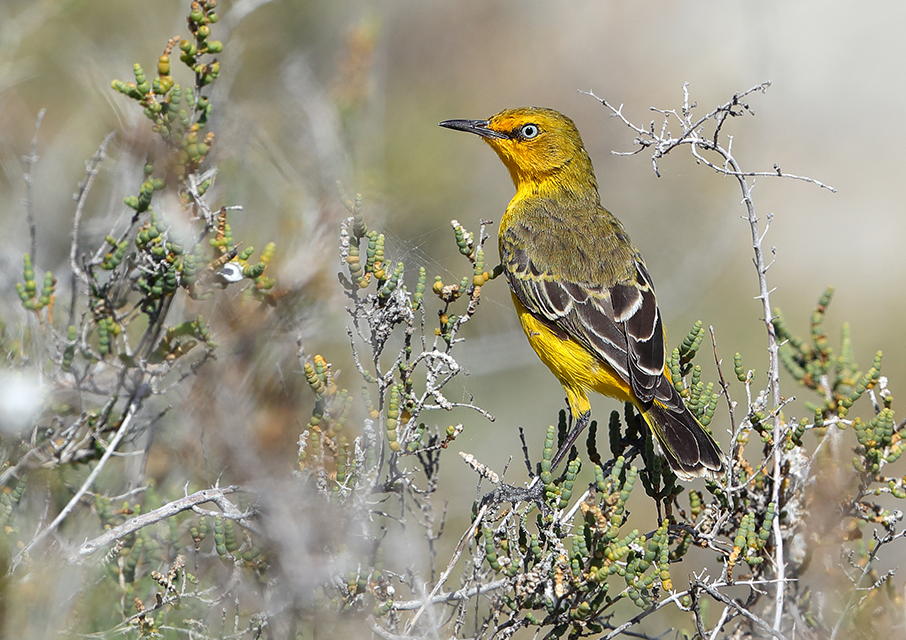Elected representatives in government are in charge of the policy and funding that can make or break saving threatened species. Their decisions and actions matter.
Capricornia has or used to have 31 threatened animals within its boundaries. One of them is me, the Capricorn Yellow Chat.
We took care to attach appropriate images that are as close to representative of each species as our resources and the availability of images allowed. However, we could not ensure perfect accuracy in every case. Some images show species that share the same genus but not at the species or subspecies level.
Capricorn Yellow Chat
Epthianura crocea macgregori
Status: Critically Endangered
The Environment Protection and Biodiversity Conservation Act 1999 (EPBC Act) lists threatened species under six categories:
Extinct, Extinct in the wild, Critically Endangered, Endangered, Vulnerable, Conservation dependent. Read more about these categories
Epthianura crocea macgregori is found across 2 electorates.
The Yellow Chat is about 11 cm in length and has a mass of about 9 g. When breeding, the adult male plumage is mainly yellow-olive above, with dusky streaking, a rich golden-yellow head and rump, and white edges to the feathers of the wings. The breeding adult male plumage is lemon yellow below, with a distinct black crescent or bar across the breast. Adult females in breeding plumage are broadly similar to adult males, but lack the distinct black mark on the breast and are generally bright yellow rather than golden-yellow in colour.¹
Explore more about this species on the Atlas of Living Australia





Explore more about the threats facing species on our Resources page.
- Aristida annua (Aristida annua)
- Hairy-joint Grass (Arthraxon hispidus)
- Bertya opponens (Bertya opponens)
- Three-leaved Bosistoa (Bosistoa transversa)
- Miniature Moss-orchid (Bulbophyllum globuliforme)
- Ooline (Cadellia pentastylis)
- Capparis thozetiana (Capparis thozetiana)
- Byfield Matchstick (Comesperma oblongatum)
- Corymbia clandestina (Corymbia clandestina)
- Glen Geddes Bloodwood (Corymbia xanthope)
- Cycas ophiolitica (Cycas ophiolitica)
- Daviesia discolor (Daviesia discolor)
- King Blue-grass (Dichanthium queenslandicum)
- Bluegrass (Dichanthium setosum)
- Salt Pipewort (Eriocaulon carsonii)
- Blue Devil (Eryngium fontanum)
- Black Ironbox (Eucalyptus raveretiana)
- Holly-leaved Graptophyllum (Graptophyllum ilicifolium)
- Three-veined Hakea (Hakea trineura)
- Waxy Cabbage Palm (Livistona lanuginosa)
- Marsdenia brevifolia (Marsdenia brevifolia)
- Neisosperma kilneri (Neisosperma kilneri)
- Neoroepera buxifolia (Neoroepera buxifolia)
- Omphalea celata (Omphalea celata)
- Ozothamnus eriocephalus (Ozothamnus eriocephalus)
- Mt Larcom Silk Pod (Parsonsia larcomensis)
- Lesser Swamp-orchid (Phaius australis)
- Pimelea leptospermoides (Pimelea leptospermoides)
- Pultenaea setulosa (Pultenaea setulosa)
- Quassia (Samadera bidwillii)
- Granite Nightshade (Solanum graniticum)
- Capella Potato Bush (Solanum orgadophilum)
- a grass (Sporobolus pamelae)
- Tectaria devexa (Tectaria devexa)
You are in federal electorate Capricornia.
